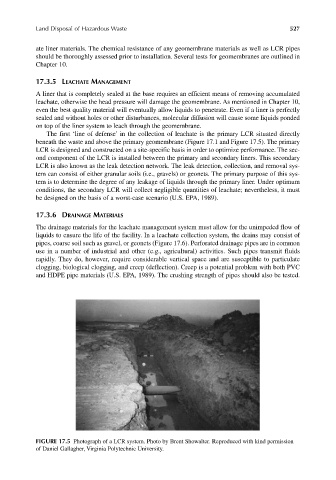Page 556 - Materials Chemistry, Second Edition
P. 556
CAT3525_C17.qxd 1/27/2005 12:44 PM Page 527
Land Disposal of Hazardous Waste 527
ate liner materials. The chemical resistance of any geomembrane materials as well as LCR pipes
should be thoroughly assessed prior to installation. Several tests for geomembranes are outlined in
Chapter 10.
17.3.5 LEACHATE MANAGEMENT
A liner that is completely sealed at the base requires an efficient means of removing accumulated
leachate, otherwise the head pressure will damage the geomembrane. As mentioned in Chapter 10,
even the best quality material will eventually allow liquids to penetrate. Even if a liner is perfectly
sealed and without holes or other disturbances, molecular diffusion will cause some liquids ponded
on top of the liner system to leach through the geomembrane.
The first ‘line of defense’ in the collection of leachate is the primary LCR situated directly
beneath the waste and above the primary geomembrane (Figure 17.1 and Figure 17.5). The primary
LCR is designed and constructed on a site-specific basis in order to optimize performance. The sec-
ond component of the LCR is installed between the primary and secondary liners. This secondary
LCR is also known as the leak detection network. The leak detection, collection, and removal sys-
tem can consist of either granular soils (i.e., gravels) or geonets. The primary purpose of this sys-
tem is to determine the degree of any leakage of liquids through the primary liner. Under optimum
conditions, the secondary LCR will collect negligible quantities of leachate; nevertheless, it must
be designed on the basis of a worst-case scenario (U.S. EPA, 1989).
17.3.6 DRAINAGE MATERIALS
The drainage materials for the leachate management system must allow for the unimpeded flow of
liquids to ensure the life of the facility. In a leachate collection system, the drains may consist of
pipes, coarse soil such as gravel, or geonets (Figure 17.6). Perforated drainage pipes are in common
use in a number of industrial and other (e.g., agricultural) activities. Such pipes transmit fluids
rapidly. They do, however, require considerable vertical space and are susceptible to particulate
clogging, biological clogging, and creep (deflection). Creep is a potential problem with both PVC
and HDPE pipe materials (U.S. EPA, 1989). The crushing strength of pipes should also be tested.
FIGURE 17.5 Photograph of a LCR system. Photo by Brent Showalter. Reproduced with kind permission
of Daniel Gallagher, Virginia Polytechnic University.

